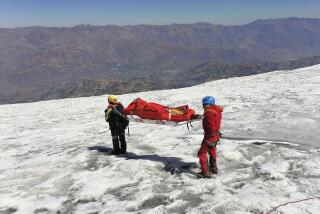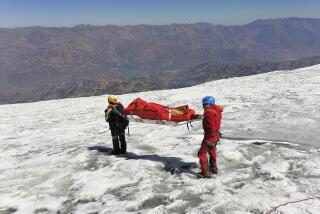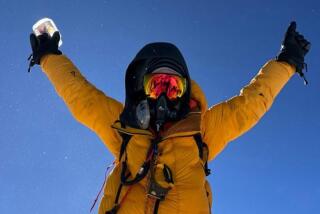Playing B Flat and Finding X at 16,000 Feet
- Share via
Ain’t no mountain high enough for Samantha Larson.
At 12, she climbed Mt. Kilimanjaro in Tanzania. On March 1, at 13, she reached the top of Argentina’s Mt. Aconcagua, the highest peak in South America.
Both ascents were international father-daughter adventures for the Long Beach eighth-grader, who needed special government permits for both climbs because of her youth.
One thing for which she must hold a world record: doing algebra homework at 16,000 feet. And how many teenagers would lug along an oboe to get in some band practice on a South American mountain?
“That was her idea,” her father, Dave, insisted. “She almost did not go on the last climb because she’s in the all-district honor orchestra. And she had rehearsals up until the day we left, a rehearsal three hours after we got home and a concert the next day.”
The pair arrived Feb. 15 at the national park below Mt. Aconcagua. On Feb. 17, they started the 23-mile, two-day trek to the base camp.
Samantha remembers very clearly Feb. 17, when she caught her first glimpse of the breathtaking mountain she was about to climb. It is the peak up which the Incas had carried and sacrificed chosen children to their deities.
Her long brown hair tucked beneath a hat and sunshade contraption, Samantha was dressed for the harsh elements that can strike suddenly at high altitude.
“I wasn’t really sure what I had gotten myself into,” she said with a shy laugh.
The sky was brilliant blue, she recalled. The snow was spectacular, the landscape barren. Not much grows above 11,000 feet. At 16,000 feet, Dave Larson said, heartbeats and breath come much faster because the altitude offers only half the oxygen of sea level.
But Samantha did fine. On March 1, the willowy honor student and her 46-year-old father reached the desolate top of the 22,841-foot mountain.
Samantha’s odyssey had begun two years earlier, when her father realized that he no longer ran regularly. Mountain climbing, he thought, would require him to stay fit. He invited his whole family to join him, but only his daughter was game.
The pair frequented Mt. Baldy in the San Gabriel Mountains and Rock Gym, a Long Beach indoor climbing center. They found that they loved the sport.
Kilimanjaro and Aconcagua were chosen because they are among the so-called seven summits of the world: the highest peak on each of the seven continents.
For Aconcagua, Samantha and her father had planned for three months, but by early February were still awaiting special approval by Argentine authorities. They needed a waiver from a regulation barring anyone under 14 from the mountain.
It was nearing the end of the climbing season in the Andes, where frosty temperatures and snow reduce the yearly window for climbing to a few short months. If the Larsons missed the chance, it would be 2003 before they could try again.
But the dean of the mountain, a legendary local guide named Fernando Grajales--known for his 50 years of climbing experience on Aconcagua--stepped in. His own son, Fernandito, a guide now himself, had ascended the peak at 16, and he was convinced that the 13-year-old American girl could do it.
Fernandito agreed to escort the Larsons, and the Grajales men made the case to local authorities, Dave Larson said.
Rather than the normal complement of two guides, the Larsons were joined by four: two men and their wives, whose presence over the two-week visit made Samantha more comfortable.
Even after the long trip to reach Mendoza, Argentina, the Larsons had to present documents showing that Samantha had no trouble climbing Kilimanjaro. She passed all the physical requirements that might have prevented her from attempting the summit, said her father, an anesthesiologist at Long Beach Memorial Medical Center.
“Right before you left base camp, the national parks system had a doctor there who examined you and checked the oxygen saturation of your blood,” Larson said.
“Many people think that the risks are even greater for kids. You have to be 18 to summit with American companies. But Samantha just does real well in high altitude. And she had trained.”
Most of their party were men in their 30s or 40s. There were a few Europeans, a couple of guys from Texas and a California girl with an oboe and homework.
Records on the youngest and oldest climbers to summit a peak are kept by local authorities in various countries, primarily because a mountain of paperwork must now be submitted on the fitness of climbers--the result of high-profile climbing tragedies.
“Samantha is definitely the youngest person to reach the summit of Mt. Aconcagua,” Fernando Grajales confirmed this week by e-mail.
Samantha never mentioned setting records during a recent interview at her father’s home on the Long Beach peninsula near Belmont Shore. It was her former English teacher at Hughes Middle School, Laura Malloy, who suggested the story to a reporter.
“She and her family are the last people who would call you,” Malloy said. “But I think this girl is just a wonderful student and yet unassuming and conscientious and caring of her fellow students. She almost didn’t go on the trip because there aren’t a lot of oboe players, and she wasn’t going to let anyone down.”
Samantha might have been the only student on the mountain, but she found no lack of interest in the subjects she was studying in school. She even got help with her homework.
“The Europeans were very interested in the mechanics of our democracy, the checks and balances and branches of the government,” Larson said. “And the Belgian guy is a mathematics tutor, so Samantha could ask him for help with some of her problems.”
Samantha also had a science project due when she returned to school. She was supposed to pose a scientific question, then find and illustrate the answer.
In what would later become her school’s entry in the district science fair, Samantha showed what happens to the body at high altitude.
On the climb, she used a portable medical device each night to check fellow climbers’ blood oxygen levels--an indicator for altitude sickness.
The guides were impressed.
“I must tell you,” Grajales said, “she is very strong, and her determination is admirable.”
More to Read
Sign up for The Wild
We’ll help you find the best places to hike, bike and run, as well as the perfect silent spots for meditation and yoga.
You may occasionally receive promotional content from the Los Angeles Times.






